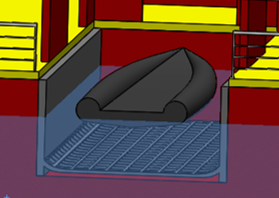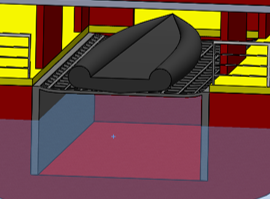The fifth generation of the University of Southampton’s supercomputers Iridis 5 has come on line. It has 20,000-cores and has a peak performance of 1.3 Petaflops. A ‘flop’ is floatng point operations per second such as adding two real numbers in a second and Peta is 1 quadrillion eg 10 to the power 15 .
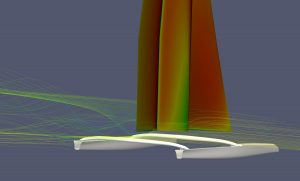
The 20,000-core machine was designed and built by high performance computing (HPC) integrator OCF using ThinkSystem SD530 servers from Lenovo. It has already emerged as one of the most powerful systems in the world, entering the Top500 supercomputer list in November,at number 251.

One of the key users over many years is our own Wolfson Unit for Marine Technology and Industrial Aerodynamics(WUMTIA) who provide a variety of Computational Fluid Dynamics(CFD) services to industry. Dr Sandy Wright, principal research engineer, Wolfson Unit at the University of Southampton comments in an OCF press release. “We have a worldwide customer base and have worked with the British Cycling Team for the last three Olympic games, as well as working with teams involved in the America’s Cup yacht race. In the past 10 years, Computational Fluid Dynamics (CFD) has become a perfectly valid commercial activity, reducing the need for physical experimentation. CFD gives as good an answer as the wind tunnel, without the need to build models, so you can speed up research whilst reducing costs. Iridis 5 will enable the Wolfson Unit to get more accurate results, whilst looking at more parameters and asking more questions of computational models.”
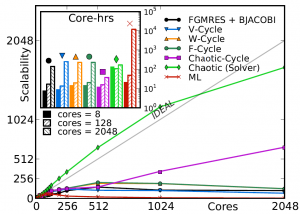
PhD students in FSI are alo important users of the Iridis computers. One example is Dr James Hawkes who recently completed his PhD in collboration with Dr Guilherme Vaz of the Refresco team at MARIN on ‘Chaotic methods for the strong scalability of CFD‘. His work investigated how best to design CFD codes of the future to work across thousands of cores.
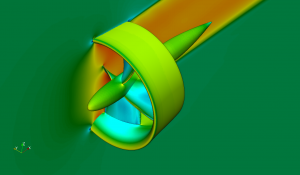
Wind tunnel tests on deep water underwater autonomous glider
As part of the BRIDGES EUH2020 (http://www.bridges-h2020.eu/). research programme the hydrodynamic performance of the external shape was successfully validaterd in the large R.J.Mitchell wind tunnel at the University of Southampton. The glider is designed to carry out long duration autonomous scientific missions down to depths of 3000m. Current underwater gliders are typically limited in depth (~150 m). This is one of the funded projects underway in the maritime robotics laboratory.
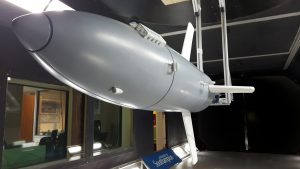
Dr Artur Lidtke , Research Fellow in the Maritime Robotics Lab at the FSI Group, carrie dout the tests over a one week period. Thanks to the size of the facility, hydrodynamic performance of the AUV could be measured at full-scale Reynolds numbers, allowing detailed quantification of drag augments associated with different vehicle configurations. The information will help to validate the design, which has been devised based on fluid dynamic simulations (CFD), allow better estimation of mission endurance, and lead to an improved understanding of performance of such AUVs in the future.
See also: https://twitter.com/BRIDGESh2020/status/956851894449827840
Maritime Robotics in San Diego for Blue Week
Dr Jon Downes attended the Maritime Alliance Bluetech week held in San Diego 6th Nov to 10th Nov as part of the UK Government delegation funded by the Foreign and Commonwealth Office Science and Innovation Network. The UK delegation included a wide range of people from UK Government, Royal Navy, MCA, NOC, UK Universities. British Embassy Washington DC, and members of the British Consulate-General in LA.
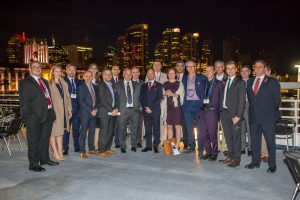
The UK Delegation attending the Maritime Alliance Bluetech Week Dinner
The delegation was visiting San Diego to build UK – US links in the Maritime Autonomous Systems sector as San Diego is home to a number of developing companies and universities. A packed week of meetings and visits ensued – visiting Scripps Institute, SPARWAR, and Coleman University Hornets Nest as part of the week. A key part of the weeks activities was the Marine Autonomous Systems UK-US Collaborative Opportunities workshop with approximately 70 attendees and a report on the discussions is expected to be made available during 2018.
The delegation attended the Maritime Alliance demonstration day witnessing some of the autonomous platforms currently under development in the US. These included the WAM-V unmanned surface vessel cooperating with underwater and aerial platforms.
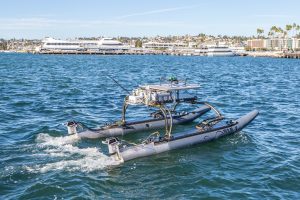
Thanks to the dedication and hardwork organising this event of David Pasquini, Nick Hooper, Natalie Hatour, and Pauline Wood of the British Consulate-General in LA, this was an excellent opportunity to build links both internationally with the USA and also within the UK Delegation itself. Some final hours were used to visit the aircraft carrier USS Midway.
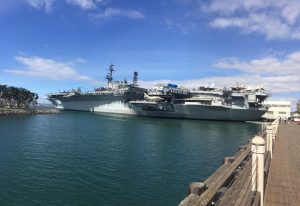
Maritime Careers
Ship Science and the University Careers and Employability Service recently held the 1st Maritime Careers Event. This was hosted on the Boldrewood campus with many companies stands and talks being given.
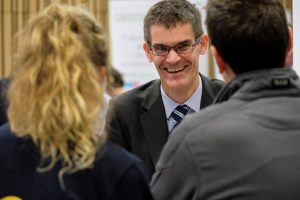
The event was well attended by 120 students from Ship science, other engineering disciplines, and maritime law during the day. Feedback from both employers and students has been very positive and we hope to be able to hold the event again next year so watch this space!

Companies attending and most of whom gave presentations included: Babcock International Group, BP, Cammell Laird, Fugro GB Marine Ltd, Griffon Hoverwork, LOC Group Ltd, LR, QinetiQ, Shell, Sonardyne, Steller Systems Ltd, Tadek, Wartsilla UK Ltd. Many of whom sent recent (or not so recent) ship science graduates!
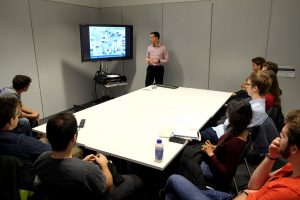
Ship Science students form part of winning concept design team
The Western Joint Branch of the Royal Institution of Naval Architects (RINA) and the Institute of Marine Engineering, Science and Technology (IMarEST) Design Challenge 2017 was won by a University of Southampton team comprising of two Ship Science students and a Mechanical Engineering student. The team of three met whilst working as interns at BMT in Bath during the summer. They struck up a friendship and decided to enter the competition.
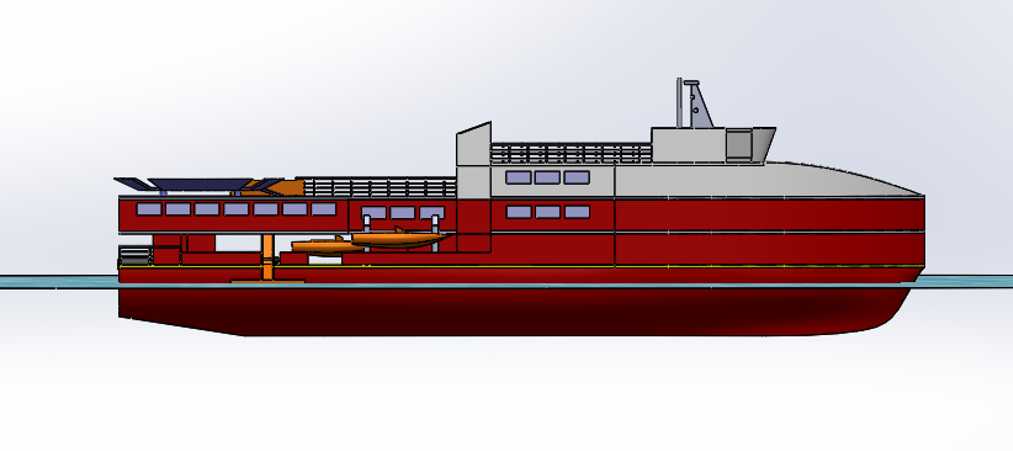
The design brief was to design a life boat capable of rescuing up to 1000 people from the sea at once, in response to the migrant crisis in the Mediterranean. “Team Wessex” was made up of James Lamyman (Part 2 Ship), Edward Wilson (Part 4 Mech) and Paloma Medina (Part 4 Ship) who was the team leader. Their mentor was Paul Nichols from Lloyd’s Register. The competition involved preparing a Poster and presenting their design concept at an event held on the 4th December at the University of the West of England.
“Team Wessex” were crowned champions from a group of 6 entrants, two from BMT, one from each of SSMG, Stellar Systems, MoD DESG and “Team Wessex”, who walked off with the £1000 first prize.
Paloma said “Sometimes it was challenging to combine University work and the lifeboat design work but we learned a lot from it and it was worth it. It was like doing a second concept design.” Part 3 Ship Science students do a concept design as part of their degree.
The entry from “Team Wessex” was a 65m monohul with various innovative rescue capabilities:
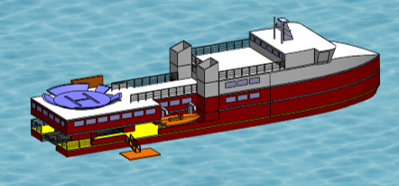
- It can seat 1000 people
- The vessel concept includes a well deck at stern for rescuing the ribs in which refugees tend to travel or collect the boats rescue ribs when they carry rescuees.
- Two high speed ribs at both sides launched,
- Side platforms which can be lowered to the water for rescuing purpose
- Vessel design integrates a processing system for rescues.
Ship Science students take part in Rolex Fastnet race 2017
Maritime Engineering and Ship Science students were scattered through the 2017 Rolex Fastnet Race fleet.
Started in 1925 when seven yachts set sail from Ryde to the Fastnet Rock to arrive in Plymouth, the infamous post-race dinner heralded the foundation of the Ocean Racing Club. Today the Rolex Fastnet Race is the most popular of the world’s classic 600 mile offshore races, attracting a diverse, international fleet of IRC yachts and grand prix classes such as the IMOCA 60s, Class40s and the MOCRA-rated multihulls.
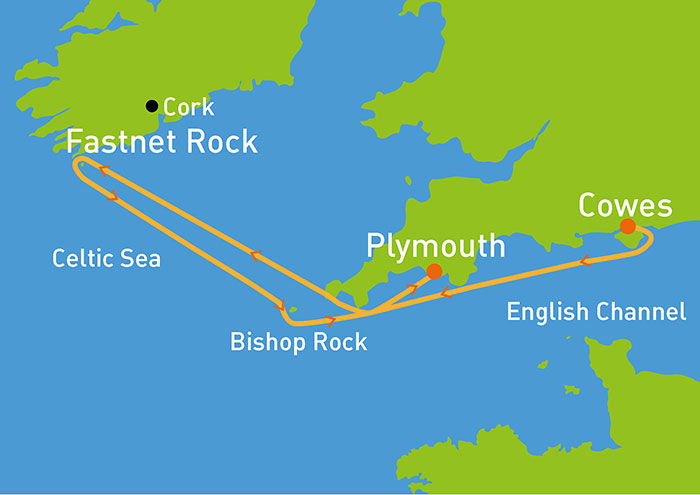
Jamie Diamond, who graduated with a first class MEng in Ship Science this summer, was the top placed student on Lady Mariposa, a Ker 46. They finished 3rd overall and 2nd in IRC class zero.

Further down the fleet James Collingwood (who also graduated this summer) sailed on the X-332 Alexa, Juliette Bataille (about to enter her final MEng year) sailed on the J122 Juno, Arthur Penet (MSc) sailed on Night Owl II a MAT 12, Duccio Ducci (MSc) on the J109 Jybe Talkin’ and Jan Chudzik (MSc) on White Knight of Wessex a HOD 35.
In addition to our students, Etienne Gauvain, from the Wolfson Unit, based at the Bolderwood Innovation Campus, sailed on the JPK 10.10 Foggy Dew.
Well done to all that took part!
Summer Schools for Future Maritime Engineers
In July we hosted not one but three residential engineering summer schools, seeing over 160 students visit and stay at the University to learn about Ship Science.
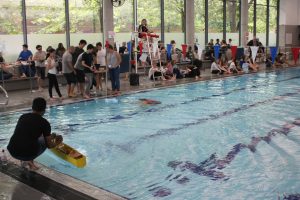
It all started with the newly designed Smallpeice Course thanks to Drs’ Arun, Francesco and Yikun! This course saw Year 9 students design, build and test wave energy converters and supply vessels.
Filming the action at smallpeice trials
This was followed by the Marine Headstart course led by Dr Joe Banks where Year 12 students designed, built and tested tidal turbines – learning all about renewables, ship science and marine engineering.
While last but not least the Design Triathlon Summer School led by Dr Nick Townsend saw Year 12 students design, build, test and race speedboats – learning all about hydrostatics, hydrodynamics and the design process.
Thanks to all those who participated and the staff and phd student who helped out over the week – it was great fun for all.
If you would like to know more about these courses and engineering outreach at the University of Southampton be sure to check out. Similar course will take place next year and are a great opportunity to learn about maritime engineering and ship science and possible careers that follow.
http://www.etrust.org.uk/marine-engineering-and-nautical-science-southampton
https://www.southampton.ac.uk/schools-colleges/design-triathlon.page
https://www.southampton.ac.uk/schools-colleges/marine-headstart.page
Delphin2 in starring role
Our long serving Autonomous Underwater Vehicle Delphin 2 features in a short 15 minute film highlighting the capabilities of autonomous vehicles to support emergency and disaster relief activities. This was made as part of an EPSRC funded UK Robotics Week Grand Challenge entry.
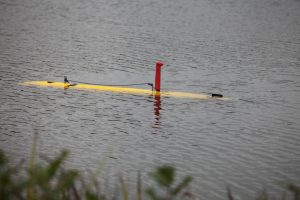
The première was well attended and a very enjoyable occasion, attracting three classes from the local school whose students were in the film as well as parents and teachers.
The film is now on YouTube for all to see https://youtu.be/eD742AI21fk
If you watch this you will of course see Delphin2, a small surface ASV and our own Dr Jon Downes making his film debut!
Good vision is everything
The marine imaging workshop 2017 in Kiel was the second workshop of this kind, bringing together engineers, researchers regulators, and industrial partners who are involved in acquiring visual imagery in the marine realm. To represent the engineering side of this challenge, Dr Blair Thornton and Sophia Schillai travelled to the GEOMAR Helmholtz Centre for Ocean Research in Kiel; Blair presented how he uses classical photography in combination with structured light from a laser to produce multi-hectare 3D Visual Maps that can be used to quantify the distribution of benthic organisms. Sophia brought a poster on the terrain following challenges for flight style AUV.

Besides presentations the workshop included several sessions for discussions on the future of marine imaging, giving a large and diverse platform to exchange what is important to those who use the data and where the challenges in aquiring and processing the data lie.
This was rounded off by a tour of the GEOMAR facilities, where on top of a diverse spectrum of research areas they were amused by the discovery of a museum model of the AUV ABYSS. It was made for a special exhibit, on of many ways how Germany involves the public in the science theme of 2017: The year of the oceans.
Shortly afterwards the annual VLC awayday conference brings together all students whose research is with the ECS group Vision, Learning, and Control (VLC). This includes several PhD students with FSI, but this year our group was also represented by Dr Blair Thornton giving the keynote. He showed how the often quite abstract research on Vision, Learning and Control is vital to getting a larger scale insight to the oceans. They cover 70% of our planet, but challenges from analysis of deep sea minerals to discovering deep-sea benthic ecosystems or monitoring the environment following disasters such as the Fukushima nuclear accident can only be solved at a large scale by applying advanced computational techniques.
PhD student Sophia completed the insight in the collaborative work between FSI and VLC by showing her work on improving the capability of flight style AUV, like Autosub6000 or BoatyMcBoatface from NOC, to stay close to complex terrains for photographic studies. Her presentation was awarded the runner-up award for the best presentation of the day.
OCEANS IV
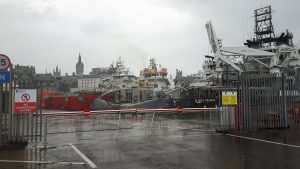
Between the 19th and 22nd June the FSI group was represented by PhD students Yu Cao and Bernat Font Garcia, as well as postdoctoral researches Francesco Giorgio-Serchi and Artur Lidtke at the Oceans ’17 conference in Aberdeen, Scotland.
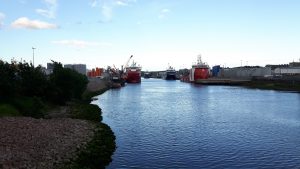
The event covered a very wide range of topics, from aquaculture, sensor technologies through to signal classification along with many more applied papers relevant to offshore structures and renewable energy. The papers presented by FSI researchers included a study of a mixed renewable energy scavenging device for an autonomous vehicle (Yu Cao https://pure.soton.ac.uk/admin/files/23591223/161201_132.pdf), development of a turbulence model for application to vortex induced vibration on riser pipes and moorings (Bernat Font Garcia https://www.researchgate.net/publication/316734503_Analysis_of_two-dimensional_and_three-dimensional_wakes_of_long_circular_cylinders), testing of a soft robot utilising shape change to propel itself (Francesco Giorgio-Serchi https://eprints.soton.ac.uk/410902/1/GiorgioSerchi_Weymouth_Oceans2017.pdf), and an experimental study of laminar flow effects on an underwater glider wing (Artur Lidtke https://eprints.soton.ac.uk/411106/).

The conference was also preceded by a day of workshops and tutorials devoted to modelling marine renewable energy devices and design of autonomous underwater vehicles (AUV). Both subjects of significant interest to many within FSI.

